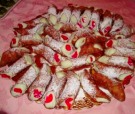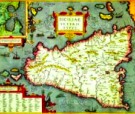|
|
 |
I PARCHI LETTERARI "IN THE DIMENSION OF THE JOURNEY"
- THE FOOD
The journey could not come to an end without having
spoken of the pleasures found at the table in this land
of marvel, which continue to amaze the sense of taste,
today as in the past...
“The abundant tables of the inhabitants of Agrigento
were famous throughout the world”
(Empedocle)
The combination of routes with the culinary specialties
from the individual locations.
“Agrigento’s cuisine offers a rich and flavourful
variety, resulting from both the influences, also with
regard to the cuisine, of the dominations that took
place throughout the territory, and the diversity among
the various areas of the province.
Along the coast and on the Pelagie Islands, the culinary
tradition is naturally associated with fish and the sea,
while inland and in the mountain areas products from the
earth prevail – oranges from Ribera, peaches from Bivona,
grapes from Canicattė, cantaloupes from Licata, olives
and oil from Caltabellotta, Bugio and Lucca Sicula – as
well as animal products such as meat and cheeses, both
fresh and aged, from Cammarata, S.Giovanni Gemini and S.
Stefano di Quisquina.
 In
the first example, included among the traditional dishes
are: cuttlefish soup, from Siculiana Marina, sole “alla
saccense” from Sciacca, sardine fish balls from Licata,
and from the distant island of Lampedusa, spaghetti
“all'isolotto” and baked snapper in meat broth. Inland
and in the mountain areas the offerings are even more
rich and varied: pasta di S. Giuseppe from Ribera, pasta
with artichokes from Menfi, pasta with fava beans and
ricotta from Montevago, pasta with chickpeas from
Favara; the “cavatelli all'agrigentina”; sweet and sour
rabbit from S.Angelo Muxaro, the stigghiola (some sort
of lamb gut) from Racalmuto, "u pitaggiu" from
Castrofilipppo" and perhaps the most original specialty
in the Province of Agrigento, the "macco" (a broad bean
soup) from Raffadali and the "tagano" from Aragona. In
the first example, included among the traditional dishes
are: cuttlefish soup, from Siculiana Marina, sole “alla
saccense” from Sciacca, sardine fish balls from Licata,
and from the distant island of Lampedusa, spaghetti
“all'isolotto” and baked snapper in meat broth. Inland
and in the mountain areas the offerings are even more
rich and varied: pasta di S. Giuseppe from Ribera, pasta
with artichokes from Menfi, pasta with fava beans and
ricotta from Montevago, pasta with chickpeas from
Favara; the “cavatelli all'agrigentina”; sweet and sour
rabbit from S.Angelo Muxaro, the stigghiola (some sort
of lamb gut) from Racalmuto, "u pitaggiu" from
Castrofilipppo" and perhaps the most original specialty
in the Province of Agrigento, the "macco" (a broad bean
soup) from Raffadali and the "tagano" from Aragona.
To this is added a tradition of wine-making that in
recent years has received numerous and important
recognitions.
Throughout the Province of Agrigento, ricotta and
almonds dominate the tradition of pastry-making:
cassatelle (small ricotta cakes) from S. Margherita
Belice and "minni di virgini" from nearby Sambuca,
almond and pistachio curled and square-shaped biscuits
from Canicattė; a rare specialty from the Provincial
seat is sweet couscous, while melon ice cream can be
tasted in the little town of Joppolo Giancaxio.”
(from the book "Culinary Itineraries in the Province
of Agrigento" Published by the Chamber of Commerce
of Agrigento).
Patrick Brydone, “Travels to Sicily and Malta”
Here is the description of a midday meal offered in
honour of the Bishop of Grigenti, Antonio Lanzi, by the
nobility of Agrigento, to which he belonged himself. A
brilliant page of literature that is also testimony to
the culinary traditions of the city’s wealthiest classes
during the second half of the 18th Century:
“We dined with the Bishop, as it had been decided,
and we left the table, convinced that the ancient
inhabitants of Agrigento could not have known the true
art of the banquet any better than their descendants, to
whom they had handed down a good dose of their virtues
and their societal vices... There were exactly thirty of
us at the table, but I can swear that there were no less
than one hundred dishes. They were all dressed with the
most succulent and delicate of sauces, which left us no
doubt as to the truth of the old Roman proverb, Siculus
coquus et sicula mensa: it is no less valid today than
in those times. Nothing was lacking that could stimulate
and tantalize the palate, nothing that could be invented
to create an appetite that was not there, as well as
satisfy it. During the sumptuous meal, some of the
favourite foods of the Roman epicureans were served, in
exactly the same manner: specifically, the moray eels,
so often mentioned by the ancient authors...
 ...
But, I realise that I have omitted some elements of the
banquet. I should have told you that it was the
sumptuous meal that the nobility of Agrigento offers
each year in honour of the Bishop. It was set up in an
immense granary at the seashore which was half filled
with wheat: a location that was chosen as refuge from
the heat. All of the serving dishes were made of silver.
Almost all of the fruit was brought to the table along
with the second course, a system that is undoubtedly
better than our own, even if it seemed strange to us.
The first dish to be passed around was strawberries. The
Sicilians were very surprised to see that we ate them
with cream and sugar; nonetheless, after a taste, they
found that the combination was not at all bad. Dessert
consisted of all types of fruit. The ice creams, which
were even more varied, were in the shapes of pears, figs,
oranges, walnuts, et cetera, and the similarity to the
fruit was so amazing that one who was not expecting them
to be made of ice cream would have been fooled. ...
But, I realise that I have omitted some elements of the
banquet. I should have told you that it was the
sumptuous meal that the nobility of Agrigento offers
each year in honour of the Bishop. It was set up in an
immense granary at the seashore which was half filled
with wheat: a location that was chosen as refuge from
the heat. All of the serving dishes were made of silver.
Almost all of the fruit was brought to the table along
with the second course, a system that is undoubtedly
better than our own, even if it seemed strange to us.
The first dish to be passed around was strawberries. The
Sicilians were very surprised to see that we ate them
with cream and sugar; nonetheless, after a taste, they
found that the combination was not at all bad. Dessert
consisted of all types of fruit. The ice creams, which
were even more varied, were in the shapes of pears, figs,
oranges, walnuts, et cetera, and the similarity to the
fruit was so amazing that one who was not expecting them
to be made of ice cream would have been fooled.
... Around six we cordially left our happy friends from
Agrigento and we boarded the speronara (a kind of ship)
at the new port.”
and the journey continues...
|



